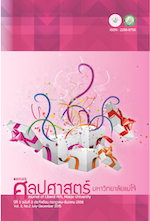พัฒนาการคำว่าลาวในเอกสารจีนโบราณ (The Etymology of Lao(s) in Ancient Chinese Manuscripts)
Main Article Content
Abstract
บทความนี้แสดงให้เห็นพัฒนาการคำว่าลาวในเอกสารจีนโบราณช่วงปีค.ศ.69-1627 ด้วยการใช้มุมมองทางประวัติศาสตร์ ผลจากการศึกษาพบว่า คำว่าลาวได้แปรเปลี่ยนไปตามบริบทของประวัติศาสตร์การเมืองเป็นสำคัญซึ่งพบข้อสังเกตที่สำคัญ 2 ประการ กล่าวคือ ประการที่ 1 ก่อนปีค.ศ.1351 เอกสารจีนโบราณ 4 ราชวงศ์ ได้แก่ ราชวงศ์ฮั่น, ราชวงศ์ถัง, ราชวงศ์ซ่ง, และราชวงศ์หยวน ได้กล่าวถึง คำว่าลาว ดังต่อไปนี้ อ้ายลาว, หรืออายหลาว, หลาว, ลาว, เมืองลาว, เหวินตัน, และลาวก๊ก ซึ่งพาดพิงหรือเรียกในความหมาย 2 ลักษณะ กล่าวคือ คน กับประเทศ ไม่อาจระบุว่าเป็นบรรพบุรุษของชาวลาวในปัจจุบัน ประการที่ 2 ช่วงปีค.ศ.1351-1627 เอกสารจีนโบราณสมัยราชวงศ์หยวนกับหมิงได้กล่าวถึงประเทศลาวและคนลาวใน 3 ชื่อ กล่าวคือ หล่าวอัว, หล่าวกัว, และหล่านจาง ล้วนมีความสัมพันธ์กับชาวลาวในปัจจุบันในฐานะกลุ่มคนวัฒนธรรมล้านช้าง
This article focuses on the etymology of the country name Laos as recorded in ancient Chinese manuscripts from 69 A.D. to 1627 A.D. Using historical approach on six selected Chinese dynasties, the study discovered that Laos as a people and a country, had two political –historical derivations. Before 1351 A.D., Han, Tang, Sung, and Yuan dynasties chronicled Laos as Ai Lao, Lao, Mueang Lao, Wen Tan, and Lao Gok, respectively. However, these sources did not cite the origins of the Laotian ancestry. Then, from 1351 to 1627 A.D., the Yuan and Ming dynasties referred to Laos with the words Lao Ua, Lao Koua, and Lan Jang. These three terms are related to the ancient Lanxang culture, which Laotians had practices for a long period of time.
Article Details
Section
Academic Article
ต้นฉบับที่ได้รับการตีพิมพ์ในวารสารคณะศิลปศาสตร์ มหาวิทยาลัยแม่โจ้ ถือเป็นกรรมสิทธิ์ของมหาวิทยาลัยแม่โจ้ ห้ามนำข้อความทั้งหมดหรือบางส่วนไปพิมพ์ซ้ำ เว้นเสียแต่จะได้รับอนุญาตจากมหาวิทยาลัยฯ เป็นลายลักษณ์อักษร

